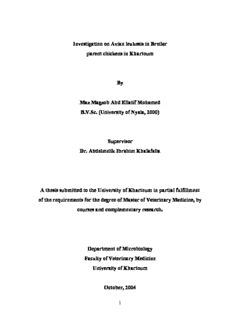
Investigation on Avian leukosis in Broiler parent chickens in Khartoum By Maz Magzob Abd Ellatif ... PDF
Preview Investigation on Avian leukosis in Broiler parent chickens in Khartoum By Maz Magzob Abd Ellatif ...
Investigation on Avian leukosis in Broiler parent chickens in Khartoum By Maz Magzob Abd Ellatif Mohamed B.V.Sc. (University of Nyala, 2000) Supervisor Dr. Abdelmelik Ibrahim Khalafalla A thesis submitted to the University of Khartoum in partial fulfillment of the requirements for the degree of Master of Veterinary Medicine, by courses and complementary research. Department of Microbiology Faculty of Veterinary Medicine University of Khartoum October, 2004 1 DEDICATION To my father, mother brothers and sister to whom I Love 2 Table of contents DEDICATION…………………………………………………..............................……..I TABLE OF CONTENTS………………………………………..............................……..II LIST OF TABLES AND FIGURES ……………………………...................................VII LIST OF ABBREVIATIONS ……………………………………………………........VIII AKNOWLEDGEMENT………………………………………………………………….X ENGLISH ABSTRACT…………………………………………………………............XI INTRODUCTION ………………………………………………………………………..1 CHAPTER ONE: LITERATURE REVIEW.........………………….............................3 1. Avian oncogenic viruses……………………………………………………………......3 1.1. Taxonomy……….…………………………………………………............................3 1.1.1. Retroviruses ……..…………………………………………………………………3 1.1.2.Herpes virus……...……………………….…………………………………………5 1.2. Morphology….………..…………………………………………………....................5 1.2.1. Retrovirus………..………………………………………………………………….5 1.2.2.Herpes virus……………….……………….……………………………………......5 1.3. Viral genome…….. …………………………………………………………………..6 1.3.1Retrovirus…………………………………………………………………….………6 1.3.2. Herpes virus……………………………………………...........................................7 1.4. Viral stability…...…………………………………………………………….............7 1.4.1. Retrovirus……….………………………………………………………………….7 1.4.2. Herpes virus………..……………………………………………………………….7 1.5. Viral replication………………………………………………………………………8 1.5.1 Retrovirus…………………………………………………….……………...............8 1.5.2. Herpes virus………………………………………………………………...............8 1.6.Epidemiology………………………………………………………………………….9 1.6.1. Distribution…………………………………………………………………………9 1.6.1.1. Retrovirus infection………………………………………………………………9 3 1.6.1.2. Herpes virus infection…………………………………………………………...9 1.6.2.Transmission…….………………………………………………………………....10 1.6.2.1. Retrovirus infection….………………………………………………………….10 1.6.2.2. Herpes virus infection……………………………………………………...........10 1.7. Manifestation of the disease………………………………………………………...11 1.7.1. Clinical signs.………………………………………………………………... …...11 1.7.1.1. Retrovirus infection …………………………………………………………….11 1.7.1.1.1. Diseases due to non defective viruses…………………....................................11 1.7.1.1.2. Diseases due to defective viruses …………………….............................. …...12 1.7.1.2. Herpes virus infection .………………………………….....................................13 1.7.2. Pathogenesis ………………………………………………………………………13 1.7.2.1. Retrovirus infection …………………………………………………………….13 1.7.2.2. Herpes virus infection …………………………………………………………..15 1.7.3. Viral susceptibility ………………………………………………………………..17 1.7.3.1. Retrovirus …………………………………………………………………. ……17 1.7.3.2. Herpes virus …………………………………………….....................................17 1.8. Diagnosis…………………………………………………………………….............17 1.8.1. Clinical diagnosis………………………………………………………………….17 1.8.1.1. Retrovirus infection……………………………………………………………..17 1.8.1.2. Herpes virus infection………………………………...........................................18 1.8.2. Histopathology ……………………………………………………………………18 1.8.2.1. Retrovirus infection……………………………………………………………..18 1.8.2.1.1. Lymphoid leukosis…………………………………………………………….19 1.8.2.1.2. Erythroblastosis………………………………………………………………..19 1.8.2.1.3. Myeloblastosis………………………………………………………………...19 1.8.2.1.4. Myelocytomatosis……………………………………………………………..19 1.8.2.1.5. Haemangiomas………………………………………………………………...20 1.8.2.1.6 Renal tumors…………………………………………………………………...20 1.8.2.1.7. Ostopetrosis……………………………………………………………………20 1.8.2.1.8.Connective tissue tumors………………………………………………………20 1.8.2.2. Herpes virus infection …………………………………………………….. ……20 4 1.8.3. Viral isolation ……………………………………………………………..............21 1.8.3.1. Cell culture ……………………………………………………………………. .21 1.8.3.1.1. Retrovirus …………………………………………………………………......21 1.8.3.1.2. Herpes virus ………………………………………………………………….21 1.8.3.2. Embryonating egg …………………………………………………………….. 22 1.8.3.2.1. Retrovirus ………………………………………………………………….... 22 1.8.3.2.2. Herpes virus ……………………………………………………………......... 22 1.8.4. Serological diagnosis ………………………………………………………......... 22 1.8.4.1. Retrovirus infection ……………………………………………………….........22 1.8.4.2. Herpes virus infection …………………………………………………………..23 1.8.5. Molecular diagnosis ……………………………………………………………....24 1.8.5.1. Retrovirus infection …………………………………………………………….24 1.8.5.2. Herpes virus infection…………………………………………………………...24 1.9. Management and control ……………………………………………………………25 1.9.1. Retrovirus infection ………………………………………………………………25 1.9.2. Herpes virus infection ……………………………………………………….........26 CHAPTER II: MATERIALS AND METHODS ……………….................................27 2.1. Study area and farm description ……………………………....................................27 2.2. Collection of samples and processing ……………………………………………... 27 2.3. Preparation and sterilization of glass wares ………………….................................. 27 2.4. Preparation and sterilization of plastic wares ……………………………………... 28 2.5. Preparation and sterilization of filters and papers ………………………………… 28 2.6. Histopathology ………………………………………………………………......... 28 2.7. Virus isolation trials……………………………………………….......................... 28 2.7.1. Preparation of samples …………………………………….................................. 28 2.7.2. Fertile eggs …………………………………………………................................ 29 2.7.3. Inoculation on the chorioallantoic membrane …………………………………… 29 2.7.4.Harvest of the chorioallantoic membrane (CAM) ………….................................. 29 2.7.5. Preparation of chicken embryo fibroblast cell culture ……....................................29 2.7.6. Inoculation of chicken embryo fibroblast (CEF) monolayers.................................30 2.8. Polymerase Chain Reaction (PCR) ………………………………………………....31 5 2.8.1. DNA extractions ………………………………………………………………….31 2.8.2. Positive controls …………………………………………………………………..31 2.8.2.1. Avian leukosis virus (ALV) ………………………………. ……………………31 2.8.2.2. Reticuloendotheliosis virus (REV) ………………………..................................32 2.8.3. Primer design and PCR conditions………………………………………………..32 2.8.3.1. Reconstitution of primers………………………………………………………..32 2.8.3.2. PCR for Avian leukosis viruses…………………………………………………32 2.8.3.3. PCR for Reticuloendotheliosis virus (REV)…………………………………….34 2.8.4. Analysis of PCR products………………………………………………………....35 2.8.4.1 Gel electrophoresis……………………………………….....................................35 CHAPTERIII: RESULTS………………………………………...................................36 3.1. Morbidity and Mortality Rates………………………………………………………36 3.2. Clinical signs……………………………………………….......................................36 3.3. Post mortem findings ……………………………………………………………….37 3.4. Histopathological findings ………………………………………………………….37 3.5. Viral isolation trials………………………………………………………………….41 3.5.1. Egg inoculation ………………………………………...........................................41 3.5.2. Cell culture………………………………………………………………………...41 3.6. Polymerase Chain Reaction (PCR)………………………………………………….41 3.6.1. PCR with primer pair H5/AD1……………………………………………………41 2.6.2. PCR with primer pair H5/H2…………………………….......................................43 2.6.3. PCR with primer pairH5/H7………………………………………………………44 3.6.3. PCR with primer pair REV-F/REV-R…………………………………………….45 CHAPTER VI: Disscussion……………………………………………………………46 Conclusion and Recommendations……………………………........................................52 References………………………………………………………………………………53 APPENDIXES…………………………………………………………………………...69 1. Preparation of Reagents and Solutions………………………………………………..69 1. 1. Normal Saline (NS)…………………………………………………………………69 1.2. Phosphate buffered saline (PBS)……………………………………………………69 1.3. Preparation of phosphate diluent (PD)………………………………………………70 6 1.4. Preparation of Stock Trypsin (2.5%..………………………......................................70 1.5. Preparation of Stock Versa(5%)………………………………………………….....70 1.6. Preparation Trypsin Versin solution………………………………….……………..70 2. Preparation of Media Additives………………………………………………………70 2.1. Preparation of Tryptose phosphate broth (29.5%) ………….....................................70 2.2. Preparation of Lactalbumin hydrolysate (5%) ……………………………………..70 2.3. Preparation of Yeast extracts solution(1%)…………………………………………70 2.4. Preparation of Sodium bicarbonate solution(NaHco3)(7.5%)………………………71 2.5. Bovine serum………………………………………………………………………..71 3. Preparation of antibiotic solutions…………………………………………………….71 4. Mycostatin……………………………………………………………………………..71 5. Preparation and sterilization of media and solutions…………….................................71 5.1. Growth and Maintenance media ……………………………………………………72 6. Preparation of Thioglycolatemedium…………………………………………………72 7. Preparation of Buffers…………………………………………………………………72 7.1. Glycerol (50%)………………………………………………………………………72 7.2. Formaline (10%)…………………………………………………………………….72 8. Preparation of materials for gel electrophoresis………………………………………73 8.1. Agarose 1% …………………………………………………………………………73 8.2. TAE Buffer………………………………………………………………………….73 8.3. Loading dye…………………………………………………………………………73 8.4. 100 bp Ladder (Invitrogen)………………………………………………………….72 8.5. Ethidiumbromide……………………………………………………………………73 ﺔﺣوﺮﻃ ﻻا ﺺﺨﻠﻣ 7 List of Tables and Figures Table1……………………………………………………………………………………34 Table 2……………………………………………….......................................................34 Figure 1………………………………………………......................................................33 Figure 2………………………………………………......................................................36 Figure 3………………………………………………......................................................38 Figure 4………………………………………………......................................................39 Figure 5………………………………………………......................................................40 Figure 6………………………………………………......................................................42 Figure 7…………………………………………………………………………………..43 Figure 8…………………………………………………………………………………..44 Figure 9…………………………………………………………………………………..45 8 Abbreviations ACOLD Arab Company for Livestock Development AGID Agar Gel Immuno Difusion ALV Avian Leukosis Virus ATV Avian Tumor Viruses C.onc Cellular oncogene CAM Chorioallantoic membrane CEF Chick Embryo Fibroblast CEL Chick Embryo Liver CIE Counter Immuno Electrophoresis CK Chick Kidney CPE Cytopathic effect DCF Direct Complement Fixation EAV Endogenous Avian Leukosis Virus EB Erythroblastosis ELISA Enzyme Linked Immunosorbent Assay HTV Herpes Turkey Virus IFT Immunoflorescent Test ISH In Situ Hybridization LL Lymphoid Leukosis LTR Long Terminal Repeat MDV Marek׳s Disease Virus PBS Phosphate Buffer Saline PCR Polymerase Chain Reaction PD Phosphate Diluent 9 PS Physiological Saline REV Reticuloendotheliosis Virus RT-PCR Reverse Transcriptase- Polymerase Chain Reaction V.onc Viral oncogene 10
Description: